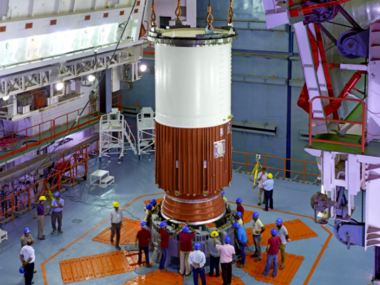The Indian navigation satellite
**IRNSS-1H** stuck inside a rocket’s heat shield — together weighing around 2.4-tonnes — now tumbling in outer space, is expected to re-enter the earth’s atmosphere in a couple of months. [caption id=“attachment_3992019” align=“alignleft” width=“380”] The core stage of the PSLV-C39 during assembly. Image: ISRO[/caption] However, there may not be any impact on the ground, said a senior official of the Indian space agency. “The satellite tracking stations are getting intermittent signals from IRNSS-1H. The fuel onboard the satellite has been depleted by firing the motors whenever there was a signal.” “The satellite-heat shield assembly is tumbling in space,” said K. Sivan, Director,
**Vikram Sarabhai Space Centre** (VSSC) told IANS on Tuesday. “The whole thing is expected to re-enter the earth’s atmosphere between 40-60 days. But the days could vary as the structure is tumbling,” Sivan added. The Sarabhai Centre is part of the
**Indian Space Research Organisation** (ISRO). On 31 August, the heat shield of Indian
**Polar Satellite Launch Vehicle's** XL variant did not separate three minutes after crossing the atmosphere. As a result, India’s navigation satellite IRNSS-1H was trapped and not put into orbit. Satellites are housed atop the rocket and covered by a heat shield or payload fairing, which protects them from getting burnt when the rocket crosses the atmosphere. Queried about the possibility of the whole structure hitting the earth and going on to be a ‘mini-Skylab’, Sivan said: “As per our current estimates whatever remains of the structure (heat shield, satellite and the rocket’s fourth stage) will fall into the sea.” The Skylab was US’ first space station that fell back to earth in 1979. It weighed around 77-ton and it was a major incident. According to Sivan, the speed at which the rocket crosses the atmosphere on its way up is much less than the speed at which the heat shield-satellite coming down would be. “The rocket crossed the atmosphere at a speed of around one km per second. On the other hand, the heat shield housing the satellite is expected to re-enter the atmosphere at a speed of eight to nine km per second,” Sivan said. “At this speed of re-entry, the whole structure is expected to get burnt,” Sivan added. Simply put, the earth’s gravitational pull increases the speed of the object that is falling towards it from the space. This increases the friction and heat, resulting in the object catching fire. The impact damage depends on the combination of mass and velocity. According to a space expert, the perigee (nearest point to the earth) and apogee (farthest point to the earth) of the satellite-heat shield assembly is around 164 km and 6,500 km. As per the original flight plan, the satellite’s perigee and apogee were to be 284 km and 20,650 km respectively. A space expert not wanting to be quoted told IANS: “The perigee will come down in course of time. Once the perigee touches 100 km then the rate of PSLV’s heat shield-satellite assembly’s fall towards the earth will be faster.” According to him, the ISRO should calculate the ground trace — the probable point of impact on the ground. Sivan said the ISRO is tracking the heat shield-satellite assembly through its stations and through its multi-object tracking radar (MOTR) at the rocket port in Sriharikota. He also said there are free space debris tracking data which is also being used by the ISRO now. “The exact spot where the satellite housed inside the heat shield will fall will be known around 36 hours before the actual impact,” the space expert said.
The Indian navigation satellite IRNSS-1H stuck inside a rocket’s heat shield is expected to re-enter the earth’s atmosphere in a couple of months.
Advertisement
End of Article


)



